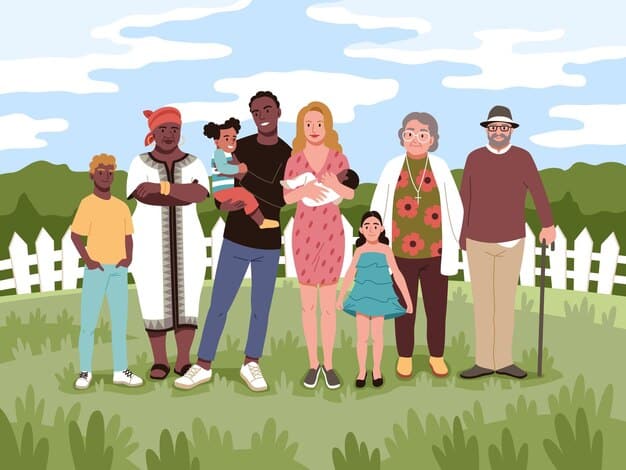Climate Change’s Impact on Vulnerable Communities: A Call for Justice

Understanding the Impact of Climate Change on Vulnerable Communities: A Call for Environmental Justice explores disproportionate climate burdens on marginalized groups, advocating for equitable solutions and policy changes to address historical injustices and build resilient communities worldwide.
In an era defined by accelerating environmental shifts, Understanding the Impact of Climate Change on Vulnerable Communities: A Call for Environmental Justice becomes not merely an academic exercise but an urgent global imperative. This exploration delves into how climate change, a phenomenon of global scale, exacts its most severe tolls on those least equipped to cope, often exacerbating existing social, economic, and health disparities.
The Disproportionate Burden of Climate Change
Climate change is often framed as a universal threat, yet its impacts are far from equally distributed. While greenhouse gas emissions are a global problem, the consequences manifest most acutely in communities that have historically contributed the least to the crisis. This introduces a fundamental issue of environmental justice, highlighting how marginalized populations bear an unfair share of environmental risks and burdens.
The term “environmental justice” emerged from a recognition that environmental hazards, from polluting industries to the effects of extreme weather, are often concentrated in low-income areas and communities of color. Climate change intensifies these existing vulnerabilities, leading to a cascade of negative effects that ripple through health, livelihoods, and social stability.
Unequal Exposure to Climate Hazards
When considering climate change, it’s crucial to acknowledge how disparate groups experience different levels of exposure to its direct hazards. For instance, coastal communities, many of which are low-income or Indigenous, face immediate threats from rising sea levels and more intense storm surges. Similarly, urban heat islands disproportionately affect residents in neighborhoods with less green space and older infrastructure, often correlating with lower socioeconomic status.
The geography of extreme weather events also plays a significant role. Droughts devastate agricultural communities, often leading to food insecurity and displacement. Flooding increasingly impacts areas with inadequate drainage systems, which are typically found in neglected urban zones. These patterns are not random; they are deeply entwined with historical patterns of segregation, economic disinvestment, and systemic environmental racism.
- 📈 Rising sea levels and coastal erosion threaten homes and traditional livelihoods.
- 🔥 Extreme heat events disproportionately affect unshaded urban areas and indoor workers.
- 💧 Increased frequency of floods impacts disadvantaged neighborhoods with poor infrastructure.
- 🌪️ More intense storms displace vulnerable populations with limited resources for recovery.
These hazards are not merely environmental; they are deeply social, reflecting and amplifying existing inequalities. The ability of a community to adapt, evacuate, or recover is largely determined by its financial resources, access to information, and political power. Those who lack these resources are left more exposed and less resilient.
Understanding this unequal exposure is the first step towards formulating equitable climate solutions. It requires moving beyond aggregate statistics and focusing on the lived experiences of those on the front lines of climate change, recognizing their unique challenges and capacities for resilience.
Socioeconomic Factors Amplifying Vulnerability
Beyond direct exposure, various socioeconomic factors significantly amplify a community’s vulnerability to climate change impacts. Poverty, lack of access to healthcare, inadequate infrastructure, and limited political representation all conspire to create a feedback loop where climate change further entrenches disadvantage. This complex interplay of factors requires a nuanced understanding to develop effective and just interventions.
Consider the economic burden: low-income households often live in older, less energy-efficient homes, increasing their susceptibility to extreme temperatures and escalating utility costs. They also have fewer financial reserves to rebuild after disasters or to relocate, often leaving them trapped in cycles of poverty exacerbated by climate events.
Health Disparities and Climate Impacts
Climate change has profound implications for public health, and again, these impacts are not felt equally. Vulnerable communities often suffer from higher rates of pre-existing health conditions due to poor nutrition, limited access to medical care, and chronic stress, making them more susceptible to climate-related health challenges. For example, increased air pollution from wildfires or extreme heat can trigger respiratory illnesses like asthma, which are already prevalent in certain disadvantaged neighborhoods.
Vector-borne diseases, such as malaria or dengue fever, are expanding their geographic range due to warming temperatures, posing new threats to communities unprepared for their emergence. Mental health also suffers, as the trauma of displacement, loss of livelihoods, and constant uncertainty about the future takes a heavy toll.
- 🌡️ Heat-related illnesses spike in communities lacking air conditioning or green spaces.
- 💨 Air pollution from wildfires and fossil fuels worsens respiratory conditions in overburdened areas.
- 🦠 Vector-borne diseases spread more easily in warming climates, affecting areas with limited public health infrastructure.
- 🧠 Mental health issues like anxiety and PTSD increase due to climate-induced disasters and displacement.
The intertwining of climate impacts with health disparities underscores the need for a holistic approach that integrates climate adaptation with public health initiatives. This means strengthening healthcare systems in vulnerable areas, providing access to cooling centers during heatwaves, and ensuring mental health support for those affected by climate events.

Furthermore, food security is a major concern. Climate change disrupts agricultural systems through droughts, floods, and changes in growing seasons, threatening the food supply. Communities that rely on subsistence farming or have limited access to nutritious food options are particularly at risk, leading to increased rates of malnutrition and food-related illnesses.
These health and socioeconomic factors are not isolated; they are interconnected, forming a complex web of vulnerability. Addressing them requires comprehensive strategies that go beyond mere environmental protection to incorporate social welfare, economic development, and robust public health interventions.
Colonialism, Historical Injustice, and Climate Change
The current landscape of climate vulnerability cannot be understood without acknowledging its deep historical roots, particularly those linked to colonialism and systemic injustices. Many of the communities now facing the brunt of climate change impacts are those that have historically been exploited, marginalized, or dispossessed through colonial policies and practices. This legacy continues to shape their capacity to adapt and thrive in a changing climate.
Colonialism often involved the extraction of natural resources for the benefit of colonizing powers, leading to environmental degradation and the disruption of traditional ecological knowledge. Indigenous communities, in particular, were dispossessed of their lands, undermining their ancestral practices of sustainable living and weakening their resilience to environmental changes.
The Extraction Economy and Its Legacy
The industrial revolution, fueled by colonial extraction of raw materials and the exploitation of labor, laid the foundation for the fossil fuel economy that now drives climate change. The wealth accumulated through these processes largely benefited colonizing nations while leaving colonized territories with environmental damage, weakened governance structures, and limited economic opportunities. This historical context directly links past injustices to present-day climate vulnerability.
Many developing nations, still grappling with the legacies of colonial exploitation, now face the dual challenge of poverty alleviation and climate adaptation. Their infrastructure is often fragile, their economies reliant on climate-sensitive sectors, and their access to global climate finance limited. This creates a moral imperative for developed nations, historically the largest emitters, to support these frontline communities.
- 🌍 Colonial-era resource extraction led to widespread environmental degradation.
- 🏞️ Dispossession of Indigenous lands severed traditional ties to sustainable practices.
- 💰 Wealth accumulation in colonizing nations came at the environmental and social expense of the colonized.
- ⚙️ Legacy industrial pollution disproportionately affects communities near former colonial trade routes/resource hubs.
The concept of “climate debt” arises from this historical perspective, suggesting that developed nations owe a debt to poorer nations for their role in creating climate change, and for the historical injustices that exacerbated their vulnerability. This debt is not merely financial; it encompasses technological transfer, capacity building, and a commitment to equitable climate governance.
Acknowledging these historical injustices is crucial for building trust and fostering genuine collaboration in climate action. It requires a shift from a purely scientific or economic framing of climate change to one that embraces historical accountability and restorative justice.
Indigenous Knowledge and Resilience
Despite being disproportionately affected by climate change, Indigenous communities around the world offer invaluable insights and practices for climate resilience. Their deep, intergenerational connection to the land, water, and traditional ecological knowledge (TEK) provides unique perspectives on sustainable living and adaptation strategies that have been honed over centuries. This knowledge, however, has often been overlooked or marginalized in mainstream climate discussions.
Indigenous worldviews often emphasize a reciprocal relationship with nature, viewing humans as part of an interconnected web of life rather than separate from it. This contrasts sharply with the extractivist paradigms that have driven much of the modern world, which contribute to environmental degradation and climate change.
Integrating Traditional Ecological Knowledge
Traditional Ecological Knowledge encompasses a vast body of understanding about the natural world, including sustainable resource management, indicators of environmental change, and adaptive responses to ecological shifts. For example, Indigenous practices of controlled burns can reduce wildfire risks, and traditional farming methods can enhance biodiversity and soil health, making communities more resilient to climate impacts.
Integrating TEK into climate adaptation and mitigation strategies offers several benefits. It provides locally relevant solutions that are culturally appropriate and often more effective than top-down approaches. It also empowers Indigenous communities, recognizing their sovereignty and rightful place in climate governance.
- 🌱 Indigenous land management practices offer sustainable alternatives to conventional methods.
- 👨👩👧👦 Intergenerational knowledge transfer builds community resilience.
- 🔄 Holistic worldviews promote environmental stewardship and balance.
- 🌾 Traditional agriculture practices enhance food security and biodiversity.
However, the integration of TEK must be done respectfully and ethically, ensuring free, prior, and informed consent from Indigenous communities. It’s not about appropriating their knowledge but collaborating as equal partners, recognizing their self-determination and the value of their unique contributions.
Beyond specific practices, Indigenous resilience is also rooted in strong community bonds, cultural identity, and spiritual connection to the land. These non-material elements are crucial for psychological and social well-being in the face of climate disruption, offering lessons for all communities striving to build resilience.
By valuing and integrating Indigenous knowledge and practices, we can foster more holistic, equitable, and effective climate solutions that honor both scientific understanding and centuries of lived experience.
Policy Pathways for Environmental Justice
Addressing the disproportionate impacts of climate change on vulnerable communities requires robust policy interventions guided by the principles of environmental justice. This means moving beyond a reactive approach to climate disasters and implementing proactive measures that tackle systemic inequalities and empower frontline communities. Policies must be inclusive, equitable, and focused on community-led solutions.
One critical pathway involves legislative action that mandates environmental equity. This could include policies requiring environmental impact assessments to specifically evaluate and mitigate disparate impacts on marginalized groups, or legislation that directs climate adaptation funding to the most vulnerable communities.
Equitable Funding and Investment
Access to financial resources is paramount for climate resilience. Policies must ensure that climate funding, whether from government programs, international aid, or private investment, is equitably distributed and reaches the communities most in need. This often requires mechanisms that bypass traditional bureaucratic hurdles and directly support grassroots initiatives.
Investing in resilient infrastructure in vulnerable areas is also key. This includes upgrading aging water systems, improving public transportation, developing green spaces to mitigate urban heat, and building climate-resilient housing. These investments not only protect communities from climate impacts but also create local jobs and stimulate economic development.
- 💰 Directing climate adaptation funds to frontline communities.
- 🏘️ Investing in resilient infrastructure in underserved areas.
- ⚖️ Implementing environmental justice policies in zoning and permitting decisions.
- ✊ Empowering local communities in climate policy formulation.

Furthermore, policies should promote a just transition away from fossil fuels, ensuring that workers and communities dependent on these industries are not left behind. This involves retraining programs, economic diversification initiatives, and investments in renewable energy that create new, sustainable job opportunities.
Beyond funding, meaningful community participation is essential. Environmental justice policies should mandate that affected communities have a seat at the decision-making table, ensuring their voices are heard and their priorities are reflected in climate plans. This bottom-up approach to policy development leads to more effective and culturally appropriate solutions.
Finally, robust legal frameworks are needed to hold polluters accountable and to protect the rights of environmental defenders who often face threats for their advocacy. Strengthening regulations and enforcement against environmental crimes is a critical component of achieving environmental justice.
Building Resilient and Just Futures
Building a resilient and just future in the face of climate change requires more than just mitigating emissions or adapting to new environmental conditions. It demands a transformative shift in how societies operate, recognizing the interconnectedness of environmental, social, and economic justice. This vision emphasizes collective action, systemic change, and the empowerment of all communities.
Resilience, in this context, is not merely about bouncing back from a disaster but about transforming systems to prevent future harm and fostering equitable outcomes. It involves strengthening social safety nets, enhancing adaptive capacities, and promoting ecological restoration.
Community-Led Solutions and Grassroots Action
The most effective climate solutions often emerge from the grassroots, driven by the unique needs and knowledge of local communities. Supporting and amplifying community-led initiatives is crucial for building genuine resilience. This includes investing in local food systems, developing community-owned renewable energy projects, and fostering social cohesion networks that can respond effectively to crises.
These grassroots efforts demonstrate that power resides not just in policy-making bodies but also in the collective action of individuals and communities working together to create change from the ground up. This involves advocacy, mutual aid networks, and the sharing of best practices.
- 🤝 Fostering strong community ties for collective action during crises.
- ♻️ Promoting sustainable practices at the local level.
- 📚 Investing in climate education and awareness programs.
- 💡 Supporting innovative, community-based climate solutions.
Education and awareness campaigns also play a vital role. Informing communities about climate risks and empowering them with the tools and knowledge to take action can significantly enhance their adaptive capacity. This includes climate literacy programs, early warning systems, and access to relevant scientific information.
Ultimately, building a just future means dismantling the systemic barriers that perpetuate inequality and vulnerability. This involves advocating for economic policies that address wealth disparities, reforming land use regulations that concentrate hazards in certain areas, and strengthening democratic processes to ensure equitable representation.
It is a long-term endeavor, but one that promises not only a more stable climate but also a more equitable and inclusive society for all. The call for environmental justice is fundamentally a call for a better world—one where planetary health and human well-being are intrinsically linked and universally valued.
| Key Aspect | Brief Description |
|---|---|
| 🌍 Disproportionate Impact | Vulnerable communities, often low-income or marginalized, face the severest climate burdens. |
| 👨👩👧👦 Socioeconomic Amplifiers | Poverty and limited resources amplify health risks and recovery challenges. |
| 📜 Historical Injustices | Colonialism and systemic racism created lasting vulnerabilities. |
| ⚖️ Environmental Justice Solutions | Inclusive policies, equitable funding, and community empowerment are crucial. |
Frequently Asked Questions About Environmental Justice
Environmental justice is the fair treatment and meaningful involvement of all people, regardless of race, color, national origin, or income, with respect to the development, implementation, and enforcement of environmental laws, regulations, and policies. It ensures no group bears a disproportionate share of negative environmental consequences.
These communities often live in areas more exposed to climate hazards due to historical injustices like redlining. They also typically have fewer resources, such as adequate infrastructure, healthcare access, and financial stability, to cope with and recover from climate impacts, amplifying their vulnerability.
Colonialism and systemic racism led to the exploitation of resources and marginalization of communities, leaving them with weakened economies, degraded environments, and limited political power. This historical context directly contributes to their reduced capacity to adapt to the present and future impacts of climate change.
Indigenous communities possess Traditional Ecological Knowledge (TEK) developed over centuries, offering sustainable practices and deep understanding of ecosystem dynamics. Integrating TEK into climate strategies provides culturally appropriate, locally effective solutions for adaptation and mitigation, fostering stronger community resilience.
Key policy solutions include equitable distribution of climate funding, investment in resilient infrastructure in underserved areas, community-led decision-making processes, strict enforcement of environmental regulations, and a just transition away from fossil fuels, all aimed at dismantling systemic inequalities.
Conclusion
The journey towards Understanding the Impact of Climate Change on Vulnerable Communities: A Call for Environmental Justice underscores a profound truth: climate change is not merely an environmental crisis but a deeply rooted social and ethical challenge. Its disproportionate burdens on marginalized communities expose the enduring legacies of historical injustices and systemic inequalities. Moving forward demands a concerted, transformative effort that prioritizes equity, champions inclusive policy-making, and recognizes the invaluable wisdom found within frontline communities. Only by addressing these intertwined crises with genuine collaboration and a commitment to justice can we forge a resilient and equitable future for all.





